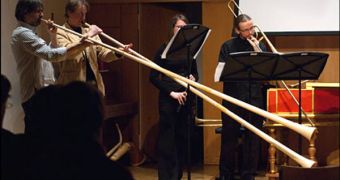Using complex computer software, researchers from the UK Engineering and Physical Sciences Research Council (EPSRC) and the University of Edinburgh managed to reconstruct a long-gone musical instrument, used for the last time some 300 years ago. The secrets of the Lituus have since been lost, and the experts had to reconstruct the instrument from descriptions of its sound and tonal range. The result was a 2.5-meter (8-foot) long tube, which plays like a sharp trumpet, but allows for vowels to be heard in between the musical notes.
The use of the instrument stretches back all the way to Roman times, some 2 millennia ago. It was fairly popular at that time, and remained in use for more than one-and-a-half millennia afterwards, until it fell out of grace. To put things into perspective, it was J.S. Bach who wrote one of the last pieces for the Lituus, the coral composition “O Jesu Christ, meins lebens licht” (“Oh Jesus Christ, the light of my life”).
Until the instrument was first played by the Schola Cantorum Basiliensis (SCB), the experts who helped recreate it had no idea how it was supposed to sound, and what types of notes would come out of it. The experts quickly realized that the Lituus had a fairly small tonal range, and that it was difficult to play, but that, when correctly used, it gave Bach's composition a “ghostly” aura, that could not be mimicked by other musical instruments accompanying the choir.
The SCB, a Swiss-based music conservatoire that specializes in early forms of music, was asked for help. No one knew what the Lituus looked like, how it was played, or how to recreate its sounds. The team said that no person alive today had at least seen a picture of it. Professors from the school gave the researchers hints on how the instrument might have been played depending on the notes it produced, and of what its tonal range must have been. Additionally, they also supplied diagrams of instruments similar to the Lituus, which indeed helped the UK team put things together.
“The software used this data to design an elegant, usable instrument with the required acoustic and tonal qualities. The key was to ensure that the design we generated would not only sound right but look right as well. Crucially, the final design produced by the software could have been made by a manufacturer in Bach's time without too much difficulty,” said Professor Murray Campbell, who supervised the creation of the software, BBC News informs.

 14 DAY TRIAL //
14 DAY TRIAL //